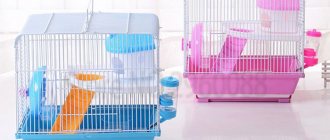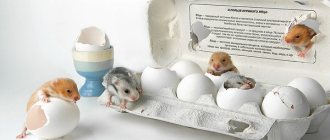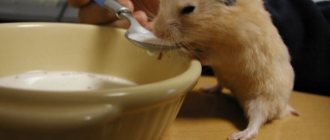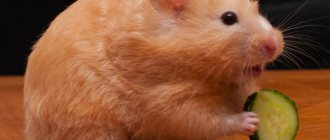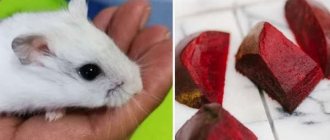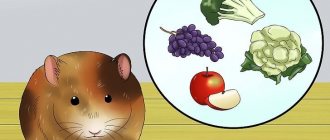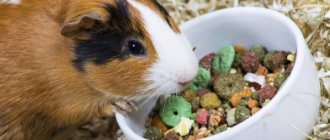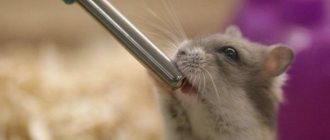When a tiny rodent becomes a family pet, owners want to extend its life.
High-quality food for hamsters is the main condition for the health and longevity of your pet. Considering the small size of these animals, you can afford to buy expensive imported food - the hamster will not eat much.
What food is best for hamsters
Few people will meticulously study the composition of hamster food in a pet store, but there are signs by which you can distinguish good food from a cheap grain mixture. Quality diet:
- does not generate dust when poured into a bowl, there are no foreign inclusions;
- does not contain dyes or preservatives;
- the grains are whole, there are no traces of mold or spoilage;
- sealed packaging.
Even the best food will not provide hamsters with all the nutrients if the pet does not eat it completely, but chooses tidbits (seeds, nuts, honey granules).
You need to look for a diet that will be well eaten by animals.
Manufacturers of premium diets indicate how much food should be given per day. If there is no such information, about ¾ of the rodent’s body weight is added. Allowed foods are those marked “for hamsters”; it is better not to give mixtures to other animals.
Forbidden food
When feeding hamsters at home, you should avoid the following foods:
- Syrov.
- Cabbages.
- Of bread.
- Fruits of exotic origin and citrus fruits.
- Sausage products.
- Sweet food.
It is better to avoid feeding your rodent dandelions. Their stems and foliage contain milky sap, which provokes irritation of the animal’s pouches.
Hot, spicy and fatty foods should not be allowed in the diet.
Food for Syrian hamsters
Food for the Syrian hamster consists mainly of grains and seeds. But even such a grain mixture can vary greatly in quality. If you rank food for hamsters, foreign manufacturers will be in first place.
Best diets (1st place)
JR Farm Hamster
The food is complete and perfectly balanced. Even if you give your hamster nothing but this mixture, he can live a long and healthy life. There is no sugar, honey or artificial additives. The basis is cereals (millet, wheat, corn), and there are also peanuts, beans, and a protein component: beef, fish, chicken.
Versele-Laga
A variety of ingredients provide your hamster with everything he needs. The mixtures are enriched with vitamins and contain (except for grains and seeds) dried vegetables, fruits and proteins of animal origin.
These diets are divided not only by type of hamster, but also by type of feeding. Nature series (all components unchanged), and there is the Complete , created similar to food for cats and dogs - in the form of homogeneous granules.
Vitacraft
Vitacraft offers pelleted diets for animals that suffer from selective eating. The manufacturer uses herbs, algae and exotic protein sources (shellfish, crustaceans, yeast) for the perfect balance.
Different diet brands vary in quality. The best is Emotion Beauty , and the most meager (and therefore flavored with honey) is Menu Vital.
Padovan
The Grandmix Cricety mixture contains many different grains and seeds, is enriched with vitamins, but does not contain a protein component.
In second place in the ranking
Fiory cricity
A large amount of honey (10%) and the presence of dye, flavoring, and preservatives force the rating to be lowered.
Little One
In addition to cereals, it contains seeds and dried vegetables.
Fiesta "Hamster"
Contains fruit and vegetable granules, seeds, nuts, sealed packaging.
In third place in the ranking
The remaining domestic brands are in third place:
- Triol;
- Animals;
- Waka.
These grain mixtures consist of 80% unhulled oats, and the grains are coated with dye. Vegetables, greens, protein foods and vitamins will have to be added to the diet additionally.
Nutritional features of hamsters
First of all, it is worth noting that hamsters are omnivores, so in addition to plant foods and grains, their diet may also contain meat. Many manufacturers in their range of food for hamsters have mixtures that contain semi-finished meat products, consisting of various small worms, bugs, midges, or produce additional snacks.
The presence of protein in the diet of an animal is mandatory.
Animals in cages, including hamsters, should never be overfed, as this is fraught with serious diseases. Unfortunately, no matter how hard people try, home conditions differ significantly from natural ones, and the pet’s activity is many times lower. Therefore, feed should be poured no more than the amount indicated by the manufacturer. At the same time, many experts recommend removing the bowl or feeder after feeding, rather than leaving it in the cage constantly. The food should be replaced rather than left in the bowl for a long time if the hamster has not finished it, since many ingredients, especially if the food is not of the best quality, can begin to deteriorate from moisture that gets into the bowl.
The type of diet for a pet must be selected depending on the hamster’s age, health status, taking into account the recommendations for a specific type of rodent.
The most popular types of hamsters today are dwarf hamsters, Djungarian and Syrian.
The popularity of these species is due to the friendliness of pets, non-aggression (not counting the breeding period of females), ease of care and nutrition. But there are also some peculiarities. For example, historically and genetically it has developed that for Syrian hamsters it is desirable to have a predominance of grains and a small amount of dried fruits in the food, but for Djungarian hamsters a greater amount of moisture and fruit is needed. And for dwarf hamsters, it is advisable to select food with smaller ingredients that can be conveniently stored in the cheek sinus.
Tips on how to properly introduce new food
You should not suddenly switch from one animal food to another. Many pet owners replace food at one time and at a time, which leads to digestive upset in hamsters. After which the first thing seems to be that the new food is not suitable. It is necessary to introduce a new type of food into the diet gradually over 7-10 days, first mixing the new food with the old one. Every day increasing the proportions in favor of new food.
What should you not give to hamsters?
For hamsters, just like for humans, there are a number of prohibited products that can cause significant harm to the health and even life of the pet.
- Any products containing spices, salt and sugar. These ingredients can lead to serious gastrointestinal diseases or diabetes. Even fruits and dried fruits that hamsters can eat should be given in limited quantities or according to individual needs;
- Flour products (yeast and yeast-free), breakfast cereals, cereals, muesli, etc., unless it is a specially designed product for rodents: the hamster’s body is not adapted to such food;
- Fruits and vegetables that are not in season or not typical for the region where they were bred. Firstly, such products are genetically alien to the hamster’s body. Secondly, it is no secret that out-of-season vegetables and fruits are often treated with special compounds for better storage, which are harmful to health;
- Any food prepared by frying, smoking, or very fatty foods should also not be present in a hamster’s diet;
- Products containing large amounts of starch should be in limited quantities;
- Dairy and fermented milk products.
What can hamsters eat?
- Vegetables (starchy and exotic with caution);
- Fruits (seasonal, not exotic);
- Dried fruits (well washed, not sticky);
- Greens (it’s better to buy special ones at a pet store, since hamsters can’t do much);
- Yolk;
- Bugs and midges;
Food for Djungarian hamsters
Food for Djungarians needs to be chosen even more pickily than for Syrians. Due to their small size, it is not recommended to give the animals unpeeled oats and seeds - injury to the cheek pouch is possible. And due to the predisposition of Campbells and their crosses to diabetes, food for dwarf hamsters should contain a minimum amount of “sweets” - honey, fruit.
The best food for Djungarian hamsters
JR Farm Classic feast
Contains wild seeds, lots of animal protein and no fruit. Suitable even for month-old jungarians.
Versele-Laga (Prestige) Mini Hamster Nature
Not suitable for Campbells due to high carbohydrate content.
Chica-bio for Djungarian hamsters
Chica-bio was created specifically for dwarf hamsters. It contains vegetables with a low glycemic index (jerusalem artichoke), meat as a source of protein, and birch twigs for grinding teeth. All components are of optimal size, which eliminates damage to the cheek pouches.
Features of keeping and feeding hamsters at home
Certain types of hamsters most often serve as pets:
- Syrian;
- Dzungarian;
- Campbell;
- Roborovsky.
The list is compiled taking into account the popularity and prevalence of hamsters of this breed. Thus, “Syrians” are found very often, while Roborovsky’s hamsters are practically never found in pet stores, and you can only buy them from a breeder.
Syrian hamsters are the largest animals, 13-14 centimeters long and weighing up to 120 grams. There are smooth-haired and long-haired (the latter are often mistakenly called “Angora”). Djungarians and Campbell's hamsters are commonly called “dwarf” hamsters. Both species belong to the genus Hairyfoot, have a length of up to 10 cm and a weight of up to 65 grams, differ mainly in color, and can produce viable offspring during interspecific crossing. Roborovsky's hamsters, also belonging to the genus of boll-legged hamsters, are the smallest: weighing up to 25 grams and up to 5 cm long.
The type of hamster directly affects its diet. Smaller furry-legged animals have a faster metabolism compared to “Syrians”; in addition, the smaller volume of cheek pouches imposes restrictions on the size of food pieces. Large manufacturers produce, in addition to “standard” ones, specialized foods for dwarf hamsters that take these features into account.
How much does hamster food cost?
You can calculate how much food for a hamster costs if you know the weight of the pet. If a Syrian hamster eats about 100 g of grain mixture per day.
| Manufacturer | Approximate price for 100 grams rub. | Food expenses per month RUB. |
| JR Farm, Versele Laga | 60 rub. | 1800 rub. |
| Vitacraft | 55 rub. | 1650 rub. |
| Padovan | 40 rub. | 1200 rub. |
| Fiory | 30 rub. | 900 rub. |
| Little One, Animals | 20 rub. | 600 rub. |
| Vaca, Triol | 17 rub. | 510 rub. |
For a dwarf hamster, this figure will be 3 times less, because a dwarf hamster eats about 30 grams of mixture per day.
Types of vitamin-mineral complexes
When choosing a vitamin-mineral complex for individuals of the hamster order, you should pay attention to the fact that they come in different types. Most often, the following forms of vitamin-mineral complexes are distinguished:
- solid - produced in the form of tablets, sold in packages and individually. In order to be sure that your hamster will actually eat them, you should first purchase several pieces;
- liquid - produced in syrup form. Usually they are buried in the animal’s mouth at the same time every day. Considering that for a hamster, being in the hands of the owner is extra stress, many breeders add them to the water poured into the drinking bowl. However, there is no guarantee that the animal will drink it immediately, and after some time the vitamin composition of the syrup product “dissipates.”
Based on the above points, experts recommend giving preference to the tablet form of nutrients. In addition, if the animal refuses to eat the tablets, they can be ground into powder and added to food, which will not affect the animal’s appetite in any way.
Can hamsters eat cat food?
They try to feed hamsters cat food as a source of protein, which pregnant females need. Dry croquettes also help to wear down teeth. But the consequences of such experiments are unpredictable. Even after just one dose, hamsters may develop diarrhea or dermatitis, and with prolonged feeding of cat food, the functioning of the liver and pancreas is disrupted, even leading to death.
A cat's diet is low in fiber and too high in fat. Although hamsters eat it with appetite (and even get used to it), it should not be given.
Tree branches and grass
Solid food is a must for a furry pet. A rodent's teeth continue to grow throughout its life, so when it eats tree shoots, it wears down its fangs.
Before submitting, the branches need to be properly prepared. Raw materials are collected away from roads, for example in the forest or in the country. Then it is thoroughly washed and scalded with boiling water to eliminate pathogens.
It is allowed to feed the hamster with branches of pear, maple, birch and apple trees.
Is it possible to feed a hamster guinea pig food?
Most often, owners of several rodents of various species are interested in whether food for guinea pigs is suitable for hamsters. Experts warn: guinea pig food should not be given to hamsters. It is suitable as an additive to the main diet, but cannot completely replace it. Guinea pigs eat grass. A hamster's diet consists of 80% grain. The composition and nutritional value of their feeds differ greatly. The guinea pig's diet contains up to 30% fiber, and hamsters - no more than 10% (6-8%). The diet for pigs is suitable for chinchillas and rabbits, but not for hamsters.
What does a rodent eat in nature?
Being an omnivore, the hamster eats almost everything that comes into contact with it. The exact diet is determined by the habitat. If a rodent lives in a steppe or semi-desert, it feeds on protein foods, including:
- Insects.
- Snails.
- Zhukov.
- Worms.
The importance of protein feed increases after hibernation or during gestation.
Field and garden individuals eat greens, fruits, cereals and vegetables. Feeding domestic pets should completely replicate the diet of their wild counterparts.
The natural instinct of hamsters is to be thrifty. Therefore, closer to the winter season, they fill up their storage. In this case, the pantry must be located in a hidden place and inaccessible to other animals. When keeping a rodent at home, you will need to periodically remove supplies, since food quickly spoils and emits an unpleasant odor.
Breed registration
There are many breeds of hamsters. The most common for home use are Syrian and Dzungarian. These animals differ in size and body strength. When compiling a diet, you should take into account the breed of the hamster, so as not to inadvertently harm the baby.
Dzungarian
Djungarians are small gray hamsters with a stripe on their back. Their weight ranges around 70 grams, and they themselves are not much larger than a mouse.
If we talk about nutrition, Djungarian hamsters, due to their small size, require more crushed food than Syrian hamsters. Their teeth are very small, and with hard food, for example, nut shells, they can damage their cheeks, which will end very badly for the animal.
In addition, these babies are not very healthy. Any spoiled product can be deadly for a baby. Before offering food to your hamster, you should make sure it is safe.
Syrian
This breed of hamster is closer to rats: they are about 17 centimeters long and their weight reaches 200 grams. In addition, the activity of the rodent begins in the evening, so it is recommended to give most of the food in the evening, and a smaller part in the morning. You should also regularly check the cage for perishable supplies: Syrian hamsters are famous for their ability to cleverly hide food.
Daily norm of vitamins
Vitamins for hamsters offered in veterinary pharmacies are usually accompanied by instructions stating how much the animals need daily. However, domestic manufacturers do not always include a letter of instruction. For this reason, you should carefully study the label on the container, and then ask all your questions to a specialist working in a veterinary pharmacy or clinic. You should not prescribe the dosage of useful elements yourself, as this can negatively affect the well-being of pets.
Diet preparation
For a hamster to live a full life, it is best to use a combined type of food. In this way, you can completely saturate the animal’s body with the necessary nutrients and enjoy the healthy state of your pet.
Basic
It is recommended to feed hamsters a sufficient amount of food twice a day. Try to give your pet the right amount of food so that he does not start stockpiling. At noon, it is best to give the animal wet food (greens, vegetables, meat, etc.) so that he cannot hide these products in reserve. By evening it is worth filling the feeders with dry food.
For pregnant and lactating females.
Pregnancy and lactation are a difficult period for the female body. Therefore, at this time, her food should be high in calories and not harm the babies and mother
Pregnant and lactating females should be fed 3-4 times a day, in the amount of 3 tablespoons of dry food. From additional nutrition you should exclude foods that cause changes in the digestive system: parsley, peas, rice, cabbage, tomato, etc.
During this period, vegetables should be given small fresh pieces of carrots, zucchini or pumpkin every day. Fruits should be completely excluded from the diet of the expectant mother, as they negatively affect the development of future offspring.
The female should be treated to protein foods 2-3 times a week. Best suited:
- boiled dietary meat;
- baby meat puree;
- boiled chicken egg;
- skim cheese.
Introduction of a new product to the menu
Introducing a new product to a hamster’s menu follows the same rules as for children. First, you should give a very small piece and see the animal’s reaction. If no changes in his condition are observed, then after a week you can treat your pet to food again. Under no circumstances should you feed your hamster the prohibited foods listed below.
